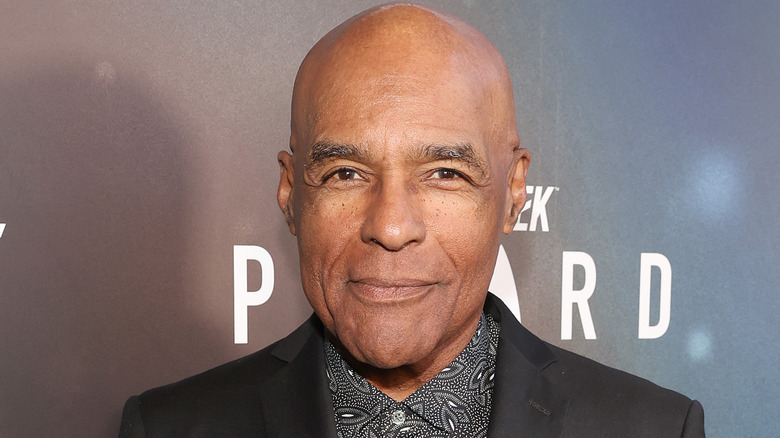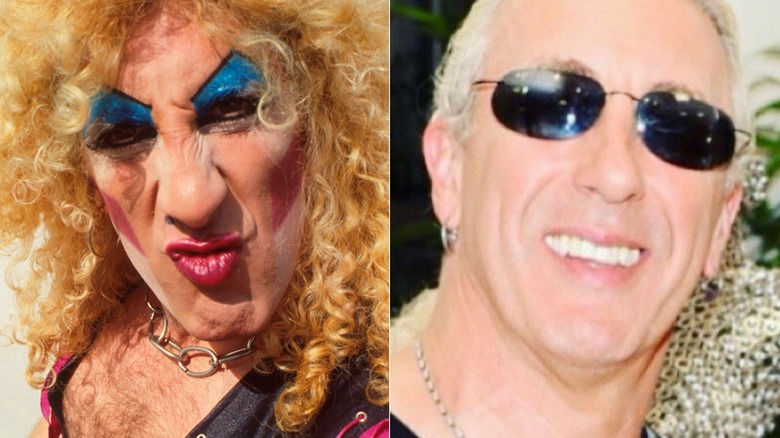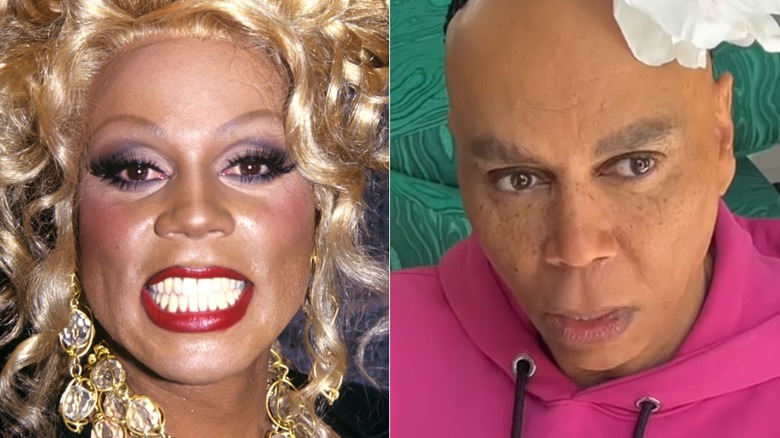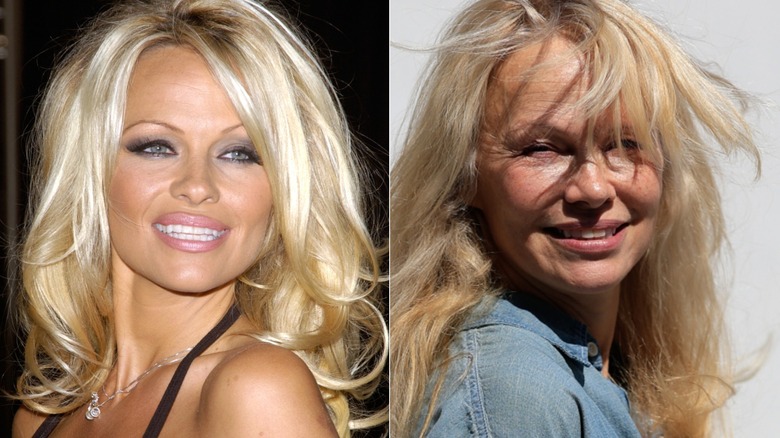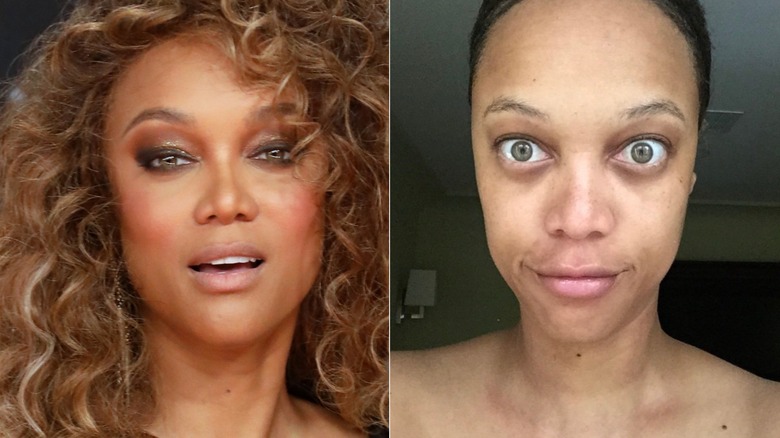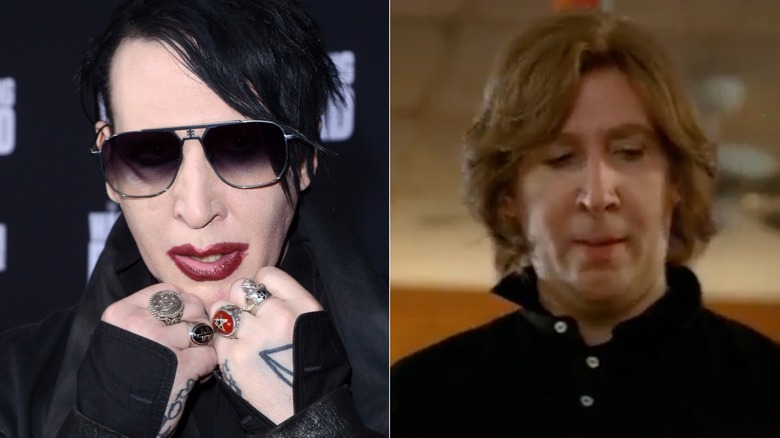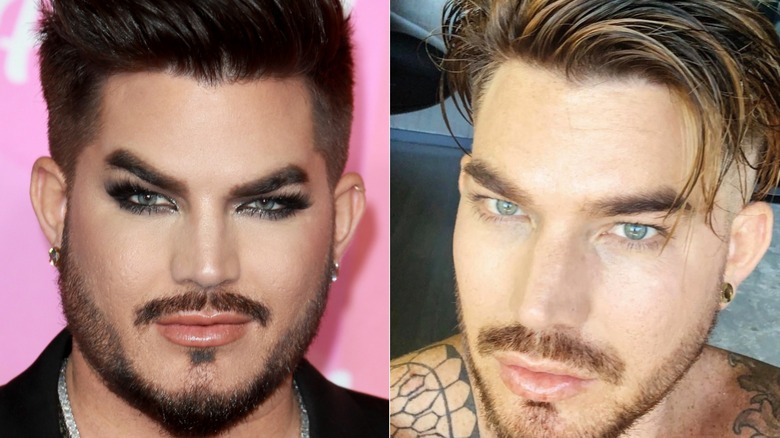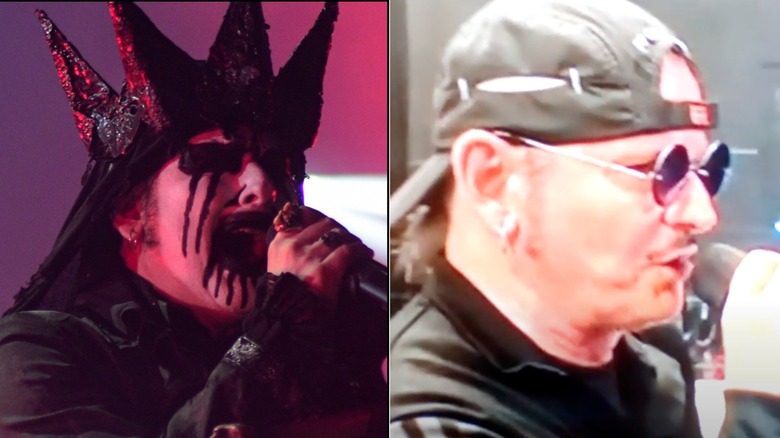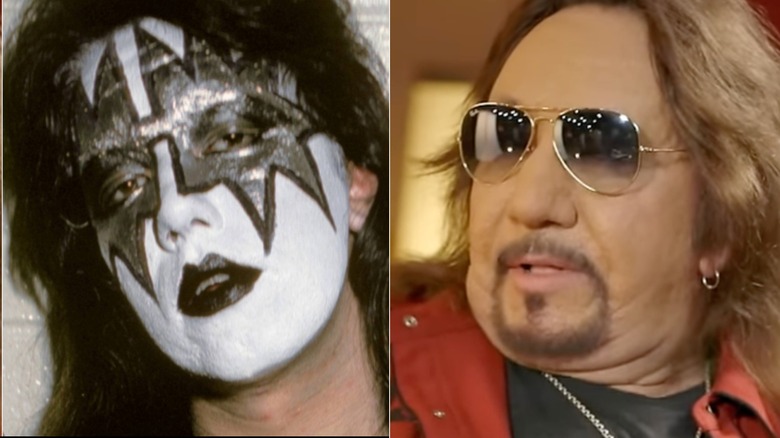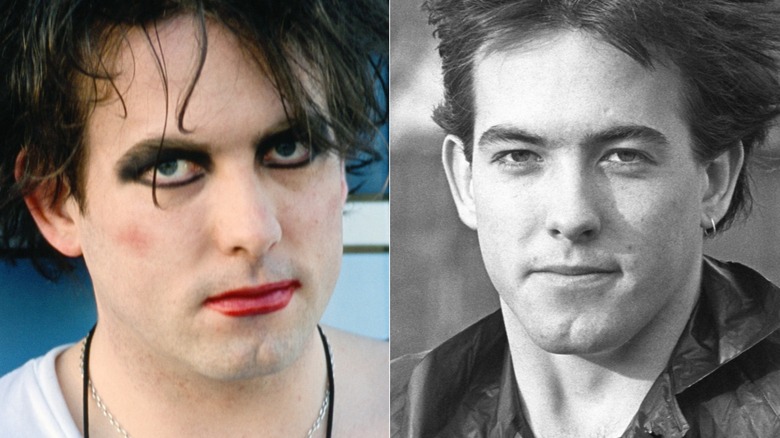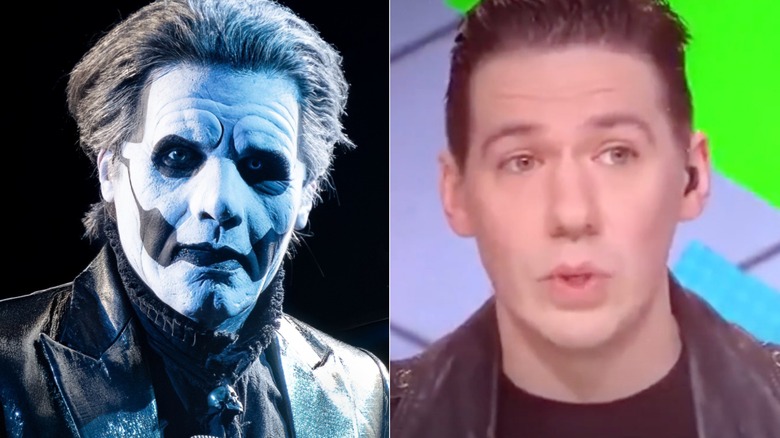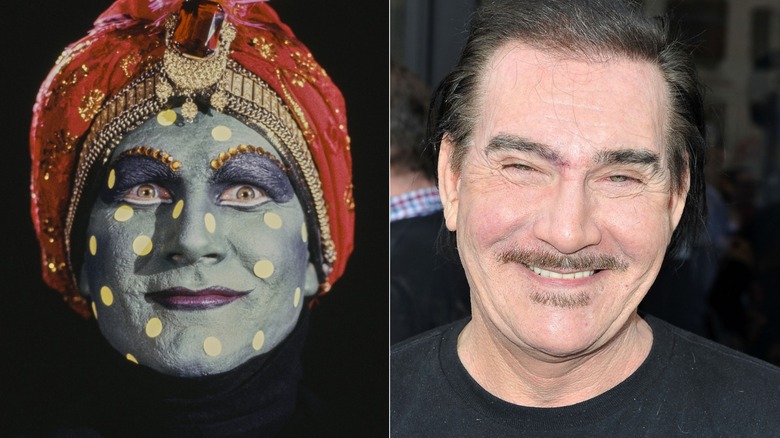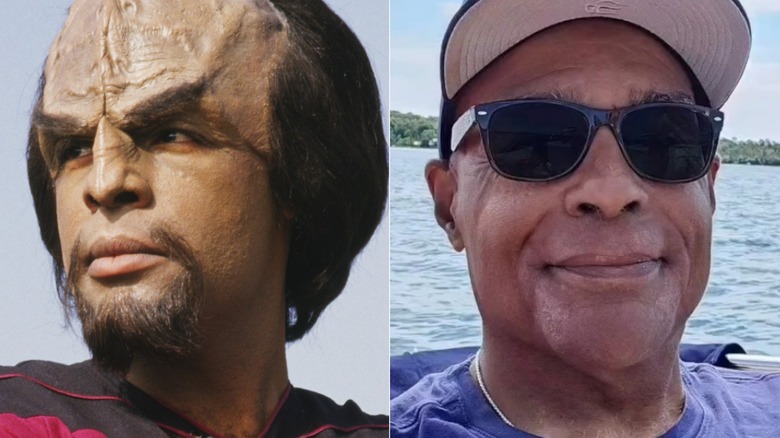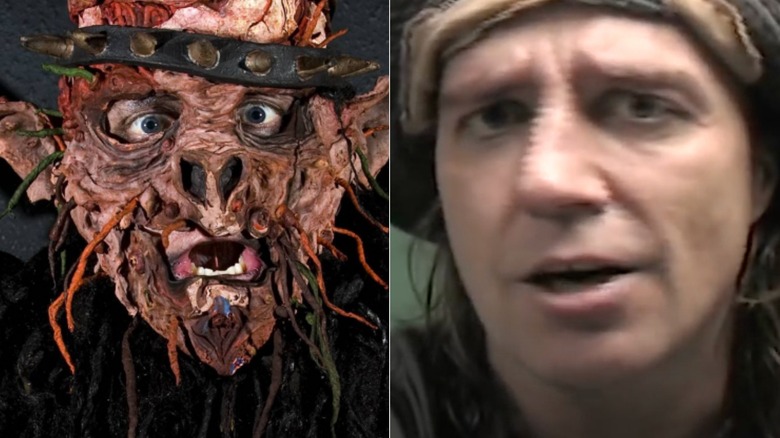Stars Who Are Unrecognizable Without Makeup In Real Life
People wear makeup for a lot of reasons, and performers of all kinds favor its use in foisting their art upon the public. Ample application of facial cosmetics can transform, enhance, or hide in part or in whole an individual's natural appearance. This is particularly true of stage and film makeup. Musicians, actors, cabaret performers, children's show stars, and those who ply their trade in horror and science-fiction make liberal use of makeup to not only play a persona or a character but to completely inhabit another being entirely.
Makeup is vital for so many artists to tend to fall on the theatrical side that it allows for a complete separation between their public and private selves. They become so strongly associated with the character they play on stage or on screen that they're virtually anonymous to fans if they aren't caked in layers of grease paint and prosthetics. Here are some of the most famous entertainers of all time who, for all intents and purposes and because of the nature of their performance style, are completely unrecognizable when they're out of makeup and out of character.
Dee Snider
Twisted Sister had only enjoyed minor success throughout the 1970s and early 1980s, but benefited wildly from the arrival of MTV. The often tongue-in-cheek hard rock party band thrived in a visual medium, with Dee Snider and his bandmates donning an abundance of tight-fitting outfits, flowing wigs, and lots of makeup. The result was a cartoonish, drag-meets-movie monster image in their eye-popping videos, built around songs in praise of general rebellion and rock n' roll, like "We're Not Gonna Take It" and "I Wanna Rock."
Received as a grotesquerie by more conservative sectors of the population, Twister Sister earned the negative attention of the Parents Music Resource Center. Formed by a group of concerned parents who were also the spouses of prominent political figures, the PRMC forced a 1985 Senate hearing about a need to label albums for explicit material. Twister Sister's "We're Not Gonna Take It" was included on the PMRC's "Filthy Fifteen," a list of the most egregiously offensive singles of the era. Dee Snider defended rock music from the government at that hearing, without his familiar makeup. He's since scaled back on the paint while performing live, written a book, and wrote the 1998 horror movie "Strangeland."
RuPaul
RuPaul's entire, multiple-media-spanning career, and his niche of entertainment, probably would've looked a lot different without makeup. Frequenting and performing in Atlanta and New York's club scenes in the 1980s, RuPaul Charles became probably the most famous drag queen in the world in the 1990s with his dance-pop recordings, movie and TV roles, and a talk show. The fame grew even more with the arrival and long run of the reality competition series "RuPaul's Drag Race." The mononymous RuPaul never failed to show up in a glitzy ball gown with perfectly done hair (or wigs) and movie-star makeup. If the goal of a drag queen is to look like a particular type of woman — a glamorous, and very traditionally feminine presenting woman — then RuPaul succeeded.
RuPaul is such a trusted name in the idea of daily physical transformation through makeup that he's been recruited to endorse multiple lines of cosmetics through Colorevolution, MAC, and Mally Beauty. The public is so used to seeing RuPaul as the performer's idea of ideal femininity that it's almost startling when he allows himself to be photographed with a bald head and makeup-free face.
Pamela Anderson
One of the most photographed and watched women of the 1990s, Pamela Anderson became a pop cultural icon and sex symbol through a variety of projects, all of which presented the actor and model glamorously decked out in intricately and copiously applied makeup. She portrayed DIY show assistant Lisa on the sitcom "Home Improvement," lifeguard C.J. on the global phenomenon "Baywatch," a post-apocalyptic nightclub owner in "Barb Wire," perhaps more popular as a poster than as a film, and she appeared on numerous covers of "Playboy." About the only time during her heyday that Anderson was widely seen without a lot of makeup was when a very private video made with then-husband Tommy Lee was stolen and distributed on the nascent internet.
By the 2020s and into her fifties, Anderson was done with makeup and what it represented to her. She started to show up at events with very little or even no cosmetics. "That was the beginning of me letting go of the image I had always had of myself. What is this cartoon character that I'd created? Okay, that was fun. But I'm not that person anymore," she told Better Homes and Gardens. "As soon as I took the mask off, the whole world opened up."
Tyra Banks
As one of the most famous and prolific models to ever grace magazine covers and runways, followed by her hosting the long-running competition series "America's Next Top Model," Tyra Banks is extremely entrenched in the beauty industry. Her job, for decades, has been to appear glamorous in public or in print, selling designer clothes by making them look good, which includes a lot of hair work and makeup application. She also once served as a spokesperson for CoverGirl cosmetics.
In June 2015, Banks took to her Instagram account to weigh in on the trend of people posting pictures of themselves to the photo-sharing service, supposedly without any edits or appearance-improving filters added. Banks used the opportunity to one-up the fad and present herself fully unadorned, without filters or makeup. "You know how people say #nofilter but you know there's a freakin' filter on their pic? Or maybe there's a smidge of retouching going on but they're lying and saying it's all raw & real? Well, this morn, I decided to give you a taste of the really real me," Banks posted on Instagram. "So...here I am. Raw. And there YOU are...looking at me, studying this picture."
Marilyn Manson
The shock-rock king of the '90s with his band of the same name, Marilyn Manson provoked the masses with purposely unsettling hard rock with explicit, transgressive depictions of violence and sexuality. His stage name serves as social commentary about the nature of fame, taking the "Marilyn" from adored movie star Marilyn Monroe and the "Manson" from notorious killer Charles Manson. Persistently famous for decades despite being held philosophically liable for the 1999 Columbine High School shooting and accused of numerous, shocking acts of sexual and physical abuse, Manson has often changed his performance appearance — he's made aggressive use of makeup to variously resemble monsters, ghouls, androgynous robots, and dead people.
Marilyn Manson is really Brian Warner, and as a side to his work as Marilyn Manson, Warner has occasionally taken on small roles in TV shows and films. He played an anonymous creep in "Jawbreaker," a prisoner in "Sons of Anarchy," and a server on "Eastbound and Down." Warner disappeared into the roles likely because he did so without any of his Marilyn Manson affectations.
Adam Lambert
Adam Lambert first came to prominence on the 2009 season of "American Idol." He finished in second place (defeated by Kris Allen), but he went on to become one of the biggest stars that the televised talent show would ever produce. Lambert charted more than a dozen songs on the Billboard Hot 100, sold half a million copies of his album "For Your Entertainment," and was deemed talented and powerful enough to fill in for the legendary and deceased Freddie Mercury in Queen
The Queen and Adam Lambert project made sense for the singer, whose music has always possessed a through-line of theatrical, glamorous, arena rock. As such, Lambert dresses the part, performing in thick, rocker makeup that harkens back to 1970s performers. He goes so heavy on the eyeshadow and eyelash treatments that when Lambert makes the rare appearance or social media post without the makeup, he doesn't look like the same guy.
King Diamond
Both as a solo act and off and on his band of more than 40 years, Mercyful Fate, Danish musician King Diamond performs very heavy, dark, and loud metal about evil, the dead, supernatural forces, and other scary things. Accordingly, King Diamond buries his true self under a lot of horror and theatrical ephemera when on stage, such as a bone-covered mic stand and a makeup job that's both pointed and frightening. Onto a base of thick, face-hiding white makeup, King Diamond generally adds various religious and occult iconography, as well as black stripes that appear to flow from his facial orifices like blood.
Rarely does King Diamond (real name Kim Bendix Petersen) appear in public in a professional capacity or perform without his persona-defining cosmetics, but he had little choice but to take the stage with a makeup-free face for a 2015 show in Milwaukee. Just before the show, the musician had been diagnosed with a serious eye infection, and his doctor said that the use of makeup could interfere with the efficiency of the medication prescribed. King Diamond sang while costumed, but bare-faced.
Ace Frehley
While coming up in the glam rock scene in New York in the early 1970s, the members of Kiss were looking for a way to stand out. The band chose an ultra-theatrical approach, adding fire-breathing, smoking machines, and lasers to its stage show while also plastering on elaborate makeup. That completely concealed the musicians' faces and each used a particular design that reflected a persona. Along with Gene Simmons as "The Demon," Paul Stanley as "The Star Child," Kiss guitarist Ace Frehley adopted the extraterrestrial deity character called "The Space Ace." Even during his solo work in the 1970s, Frehley performed in his signature makeup, but he was out of the band (for the first time) by 1982, a year before Kiss would try to reverse its waning popularity by having the band drop the makeup and the characters.
Frehley, virtually unrecognizable without two silver stars on his face, went on to front the hard rock band Frehley's Comet in the 1980s and reunited with Kiss for an episode of "MTV Unplugged" in 1996. Nobody wore face-paint for that reunion show, and with the retirement of Kiss official, it's unlikely Frehley will ever be "The Space Ace" again.
Robert Smith
As a band, the Cure is inexorably intertwined with Robert Smith, its founder, lead singer, guitarist, longest standing member, and chief musical architect. Through the Cure, Smith inspired and pioneered the melancholy-meets-gloomy goth rock sub-genre as well as the look adopted by its fans. Smith is well-known for keeping up the same appearance for about 40 years: black clothes, wild black hair, and ghostly makeup involving some combination of pale foundation, heavy eyeliner, and red lipstick, often smeared.
That look didn't begin when the Cure started up in the late 1970s, and neither did the dark, haunting, atmospheric sounds most commonly associated with the band. The Cure didn't adopt its most famous and final form until the release of its fourth studio album, 1982's "Pornography." Before turning into a keyboard-driven, moody rock band, the Cure formed as a tight, sparse, three-member post-punk outfit. By the late 1980s, Robert Smith, who's worth a lot more than you think, was rocking the look that made him famous, moving on from his style in the early days of the band, when he posed for publicity photos with conservative clothes, a clean-cut hairstyle, and no makeup whatsoever.
Papa Emeritus IV of Ghost
After performing with the Swedish band Repugnant in character under the name Mary Goore, Tobias Forge created Ghost in 2010, as much of a performance art collective as it is a pop-metal act. With songs and a stage show that combine tropes from horror movies, the darkest parts of the supernatural, and organized religion, Ghost is comprised of spookily cloaked and made-up "Nameless Ghouls." Except for Forge, that is, who has taken on several personas, including Papa Emeritus II, supposedly dismissed and replaced by Papa Emeritus III, and then Cardinal Copia and Papa Emeritus IV. Frequently donning traditional papal clothing, Forge usually takes the stage in ghoulish black and white makeup.
The identity of Ghost's front man wasn't public knowledge until an unpaid royalties lawsuit from former band members led to its disclosure, and Forge didn't appear in public without any of his Papa Emeritus or Cardinal Copia disguises until a 2019 interview.
John Paragon
Primarily a writer, John Paragon toiled behind the scenes to help develop two of the most recognizable figures of the 1980s. While working with the Los Angeles comedy troupe The Groundlings, Paragon met actor Cassandra Peterson and helped her hone her campy comic-horror character Elvira, while he co-wrote her TV specials and film "Elvira: Mistress of the Dark." He also collaborated closely with fellow Groundlings member Paul Reubens and helped turn the latter's man-child character into the stage play "The Pee-wee Herman Show." Adapted for children's television as "Pee-wee's Playhouse," Paragon was heavily responsible for that show's look and feel, serving as a staff writer and directing 20 episodes. Most notably, he also covered himself in blue face paint and thick eyeshadow, and donned a head scarf and body-obscuring garments to play Jambi, Pee-wee's impish and obnoxious wish-granting genie.
Paragon died at his home in southern California in 2021 from heart disease and chronic alcoholism at the age of 66, joining the list of "Pee-Wee's Playhouse" actors who sadly passed away.
If you or anyone you know needs help with addiction issues, help is available. Visit the Substance Abuse and Mental Health Services Administration website or contact SAMHSA's National Helpline at 1-800-662-HELP (4357).
Michael Dorn
"Star Trek" is one of the most successful and far-reaching franchises of all time, and no one has appeared in more entries than actor Michael Dorn. He then played no-nonsense Lieutenant Worf in four feature films and nearly 300 episodes, first as a member of the main cast of "Star Trek: The Next Generation" before joining "Star Trek: Deep Space Nine" and "Star Trek: Picard." He's reprised the role of a mostly agreeable Klingon, an alien race with a messed-up history in "Star Trek," in various video game adaptations while also racking up dozens of credits as a voice actor. Portraying Lieutenant Worf off and on for nearly 40 years and turning in performances mostly over a microphone left Dorn with a relatively high amount of privacy for an actor of his stature. So much makeup and prosthetics are required to provide Dorn with a wide, mountainous forehead that he doesn't even look like the same person without it.
"The anonymity is great. And I like the effect it has on people when I tell them who I am," he told the Los Angeles Times. "They hear the voice and say, 'Do I know you? Who are you?' And when I tell them, they're floored."
Oderus Urungus
While fronting a Virginia metal band in the 1980s, Dave Brockie got stuck with costumes from a never-made low-budget horror sci-fi movie, so he combined the two concepts into GWAR. A heavy band with a massive backstory, GWAR's members positioned themselves as exiled alien monsters that performed aggressive, profane metal songs about violence, war, intergalactic mythology, and their desire to destroy the human race. GWAR shows are a chaotic swirl of noise, special effects, audience participation, and gallons of fake blood, and for decades the entire operation was led by Brockie as Oderus Urungus, a 43 billion-year-old beast from the planet Scumdogia.
The members of GWAR almost always remained in character, even during an appearance on "The Jerry Springer Show," while Brockie would remove the masks, makeup, accessories, and costumes for the occasional interview with a small media outlet. In March 2014, Brockie was found dead in his home in Richmond, Virginia. A toxicology report pertaining to the tragic death of Gwar's Brockie determined that the 50-year-old performer died of a heroin overdose.
